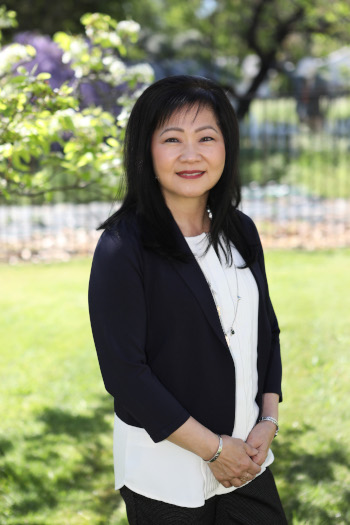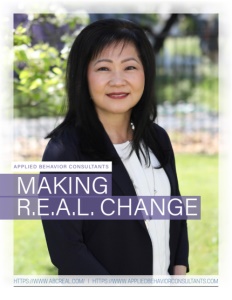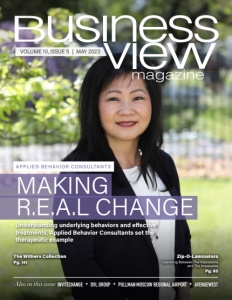Applied Behavior Consultants, Inc.
making R.E.A.L change
Understanding underlying behaviors and effective treatments, Applied Behavior Consultants set the therapeutic example
When people talk about autism being a spectrum disorder, what they mean is that individuals can be affected differently, despite sharing some common traits and triggers. Dr. Stephen Shore, an autistic professor of special education at Adelphi University, famously said, “When you’ve met one person with autism, you’ve met one person with autism.”
In other words, autism is a diverse and often divided continent to navigate; in many ways, it functions as a culture more than a condition, largely due to its innate tendency to affect how autistic individuals behave, understand, and communicate with the world around them.

Ms. Brenda Terzich-Garland, CEO
That’s the premise from which Applied Behavior Consultants (ABC), a human services agency specializing in learning disorders and developmental disabilities, begins the process of helping kids with autism, their families, and their communities. The firm delivers programs that operate within the theoretical practices of Applied Behavior Analysis (ABA), and deploy what Co-Founder, President, and CEO, Ms. Brenda Terzich-Garland M.A., B.C.B.A., calls the R.E.A.L. Model™ (Recreating Environments to Accelerate Learning) of ABA treatment.
Using this practice as a guide for analyzing behavior change and teaching language, play, self-care and social competence with family, peers and in the community to build relationships, the agency’s broader mission is to act with compassion, work from a team approach, and provide whatever is in the self-interest of each individual and family served.
“I call it the three ‘Cs’ of empathy in action,” Ms. Terzich-Garland explains. “We talk about compassion, where we want to see that person’s humanity. We talk about communicating that person’s perspective, in order to make that connection with the individual. That holds true not only for the parents we work with but for the staff we train to be able to provide this intervention. We also try to provide appropriate choices, to allow people to set boundaries around what they feel they can and can’t do. Everybody wants a say about their environment—it can’t just be ‘You do as I say’ and that’s the end of the story.”
As an ABA service, ABC uses an evidence-based discipline model rooted in behavior analysis and principles of learning. ABA therapy applies our understanding of how behavior works to real situations, with the goal of increasing behaviors that are helpful while decreasing those that are harmful or affect learning.
“It gives us the ability to identify behaviors that are deficits in the child’s repertoire, or ones that prevent the child from learning as compared to typical kids,” clarifies Terzich-Garland. “The U.S. has certainly brought more attention to ABA as an intervention for treating autism spectrum disorders (ASDs), but it’s also commonly used in Canada, Australia, and Europe with the same clientele. With the science of behavior analysis, we use learning principles like reinforcement consequences to teach critical skills and repertoires, redirect problem behavior and give the child choices to have control over the learning environment.”
“We hone in on what the child actually needs to learn in order to function fully in his environment. If you think about how kids learn how to talk, first they perceive sounds. They start imitating what they hear their parents say through babbling, and eventually those form into words and they’re able to socially reciprocate when someone interacts with them,” she continues.
“When children with autism aren’t able to do that, we can teach them to discriminate and break down those skills of hearing sounds, developing words, and functionally communicating with others. We can do the same thing with play behavior because most kids with autism don’t play based on what is typically expected—instead, they’ll spin objects, or they’ll walk back and forth. Those repetitive behaviors will vary from child to child, but the point is they’re not engaging, and not interacting with family members. So, ABA is the intervention—or, what we call the ‘prescription’ for ASD.”
As the evolution of ‘autism’ as a diagnosis shifted the recognition of ABA services from an educational therapy to a medical intervention so too did ABC’s business operations change. Based on funding source and service need, they mainly provide center-based ABA services and an option for in-home intervention as necessary. They continue to provide school consultation and support when clients transition out of treatment.
Providing ABA in the treatment of autism for over 30 years remains constant and still highly needed. However, ABA as a discipline continues to evolve within the practice of behavior analysis, thus ABA treatment must be progressive to meet the individual changing needs of every person served.

“To me, the biggest gain we’ve made in our field specific to autism is the fact that it’s now recognized as a medical disorder,” Terzich-Garland says. “We used to have our own schools for children with autism, one down in Southern California and one here in Sacramento. That was when we were funded by governmental agencies and school districts. Children were placed with us by a public school district in their county and we offered them intensive behavior intervention.”
“Now, if you want to make a distinction between what’s education and what’s healthcare, I think it’s specific to who funds it and how they perceive the disorder. But we’ve moved from providing those services in a school setting to what we call clinical centers. So now, it’s all either center-based or in-home.”
For those parents who aren’t able to accommodate the necessary changes to the home environment, center-based services tend to be the preferred option to deliver ABA intervention, whereas in-home services are usually offered to families who cannot meet the treatment schedule on site, or the child has special circumstances that are not suitable for center-base. ABC currently has 7 centers operating out of Sacramento and the greater region, East Bay, Stockton, Inland Empire, and the North L.A. area and 3 international centers in Singapore, Philippines and Portugal. All US and International regions offer in-home ABA services as an option for parents.
“We favor center-based because the ability to monitor quality control and clinical effectiveness is higher,” Terzich-Garland insists. “But, if you’ve ever had an opportunity to watch ABA intervention in action, you’ll know that it doesn’t matter what setting per se the intervention occurs. The environment is always structured in such a way that we’re able to identify stimuli that we want the child to respond to. Whether it’s teaching them to make sounds, put words together, or learn play skills, we work with the environment to build those unit responses into more complex repertoires where the child is able to thrive and interact with peers and family members.”
From a business perspective, Terzich-Garland found the ESOP concept was one of the most natural ways of maintaining the legacy of this R.E.AL. Model™, which she developed over 25 years of clinical ABA experience with ASD kids, and to ensure the integrity of its delivery.
“I developed the R.E.A.L. Model™ as a conceptual framework to teach for generalization within ABA intervention, and I wanted to stay true to that model to make sure that it was interwoven with every aspect of our company and specifically, in the way that we went about training staff at any level”.
“I don’t just mean clinical people—when you look at our administrative billing team, our operations team, they’re just as committed to that process in the way that we provide intervention. The ESOP was a way for my business partner, Dr. Joseph Morrow, and myself to ensure that the integrity of treatment was maintained, that we remained effective in our treatment, and that we delivered those services with compassion to each child. That means that every client who comes our way gets served in the way that Joe and myself intended to do it.”
Dr. Morrow heard about the ESOP option while away on a salmon fishing trip in Alaska. A fellow fisherman happened to ask him if he’d ever considered doing an ESOP. By the time they got done talking, the gears were already in motion to make the benefits plan a reality.
“Joe came back and said, ” I have a thought,” Terzich-Garland recalls. “We’ve been talking about how we could get our company to last over time, to where we can really get employees invested in our mission. Why don’t we start an ESOP?
“In the end, we agreed it would give us an opportunity to bring our staff together, to train them in a way where they can align their values with our company values, and provide a benefit to the employee to participate in an organization and to have a retirement plan secured in the way that we run our company.”
Terzich-Garland believes the ESOP already resonates with her core staff but that more time would need to be invested to increase employee awareness of value alignment overall.
“Here’s the struggle—as an owner and as a trustee, making sure that the ESOP is sustainable, when you tie in money, or a retirement plan, and you don’t talk about it often, then it kind of gets forgotten,” she reports.
“We have to invest training time to cultivate the type of culture where we identify our employees’ values and have them align with the company’s values. Because unless those two things correlate, I don’t think that employees are going to think beyond, Oh, I’m part of an ESOP. They have to see the value they’ve navigated in the workplace. They also have to be committed, to wanting to be navigated by that value, as a way to ensure the sustainability of the ESOP from which they will benefit. Until those things are tied together, I think they’re seen as separate things.”
“One piece of advice I would give to anybody considering an ESOP is that you must tie the ESOP in with the mission and values of the company such that you bridge that gap between the ESOP and the employees’ values and their own worth in the company,” she maintains. “If you don’t, then they’ll just get a statement every year, and that’ll be it.”
AT A GLANCE
Applied Behavior Consultants, Inc.
What: leading human services agency specializing in ABA Treatment for autism/ASD and other learning and behavioral disorders
Where: USA Regions – Sacramento, Elk Grove, Stockton, Bay Area (Walnut Creek) North Los Angeles (Santa Clarita and Antelope Valley/Lancaster) and Ontario/Inland Empire.
Website: https://www.abcreal.com/ and https://www.appliedbehaviorconsultants.com
PREFERRED VENDORS
ABA Technologies – www.abatechnologies.com
The business landscape of today offers unprecedented challenges for workplace learning.
Growing competition, turnover, and technological change require effective and efficient
upskilling.
At ABA Technologies we combine behavioral science, cutting-edge instructional design, and
technology to partner with you in addressing these challenges.
How do we do that?
• We produce and implement onboarding and upskilling solutions that can be precisely
customized to your organization’s unique needs.
• Solutions are designed to engage increasingly more discerning and time-constrained
learners.
• We connect training outcomes to business results in a measurable manner.
Holistic Learning Solutions That Stick
When you purchase training programs for your workforce, you have a right to expect that their
learnings will sustain. We extend a promise of return on your learning investments through our
innovative instructional design and performance sustainability technology.
The four components of our behavior-based learning architecture:
1. Assess your business
2. Define the ideal
3. Customize your solution
4. Embed into your culture
The American Society for Training and Development (ASTD) collected training information
from over 2,500 firms and found that companies that offer comprehensive training:
• Have 218% higher income per employee than those with less comprehensive training.
• Enjoy a 24% higher profit margin than those who spend less on training.
• Generate a 6% higher shareholder return if the training expenditure per employee increases
by $680.
Zabarsky & Associates, LLC – www.zaretirement.com



